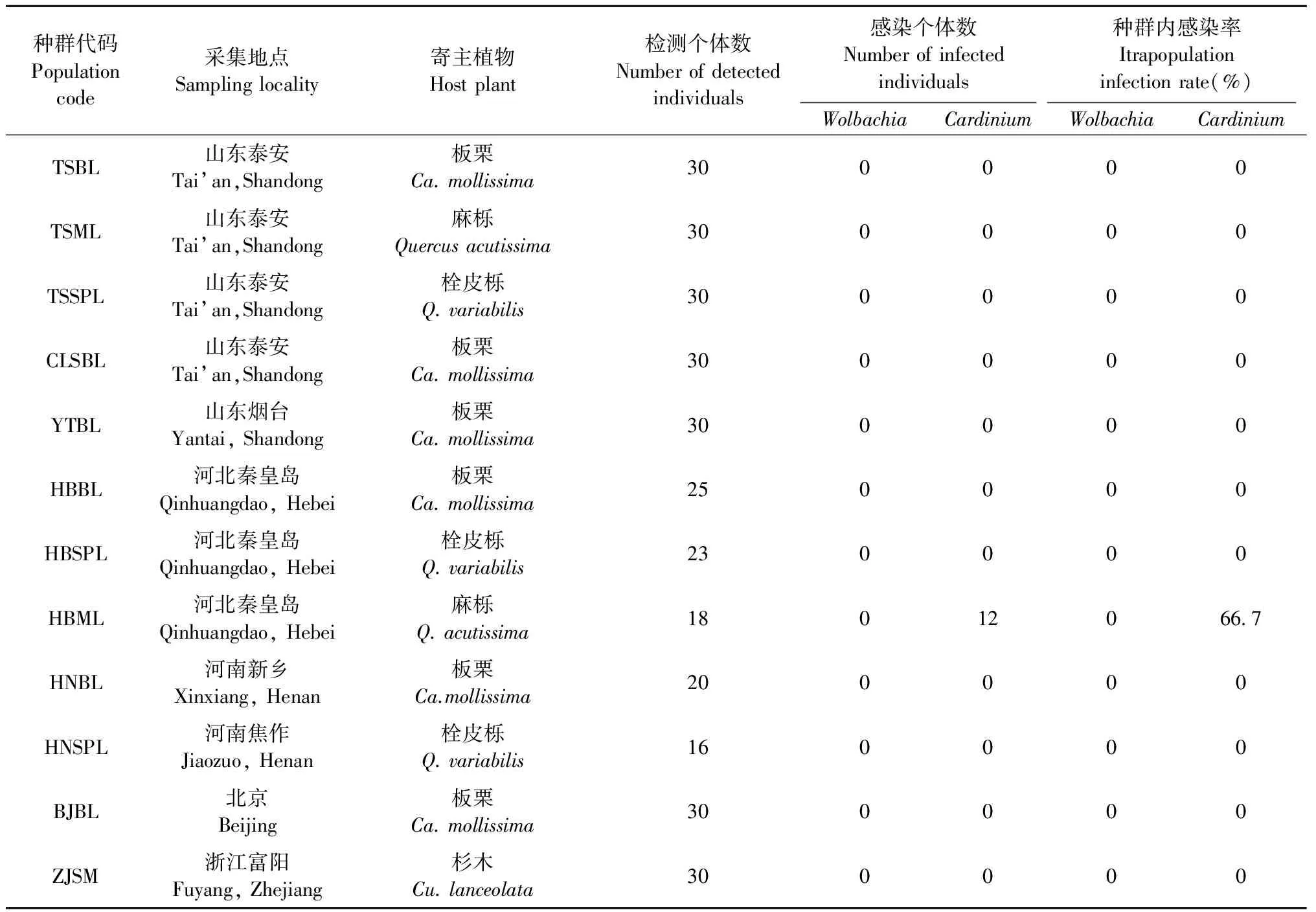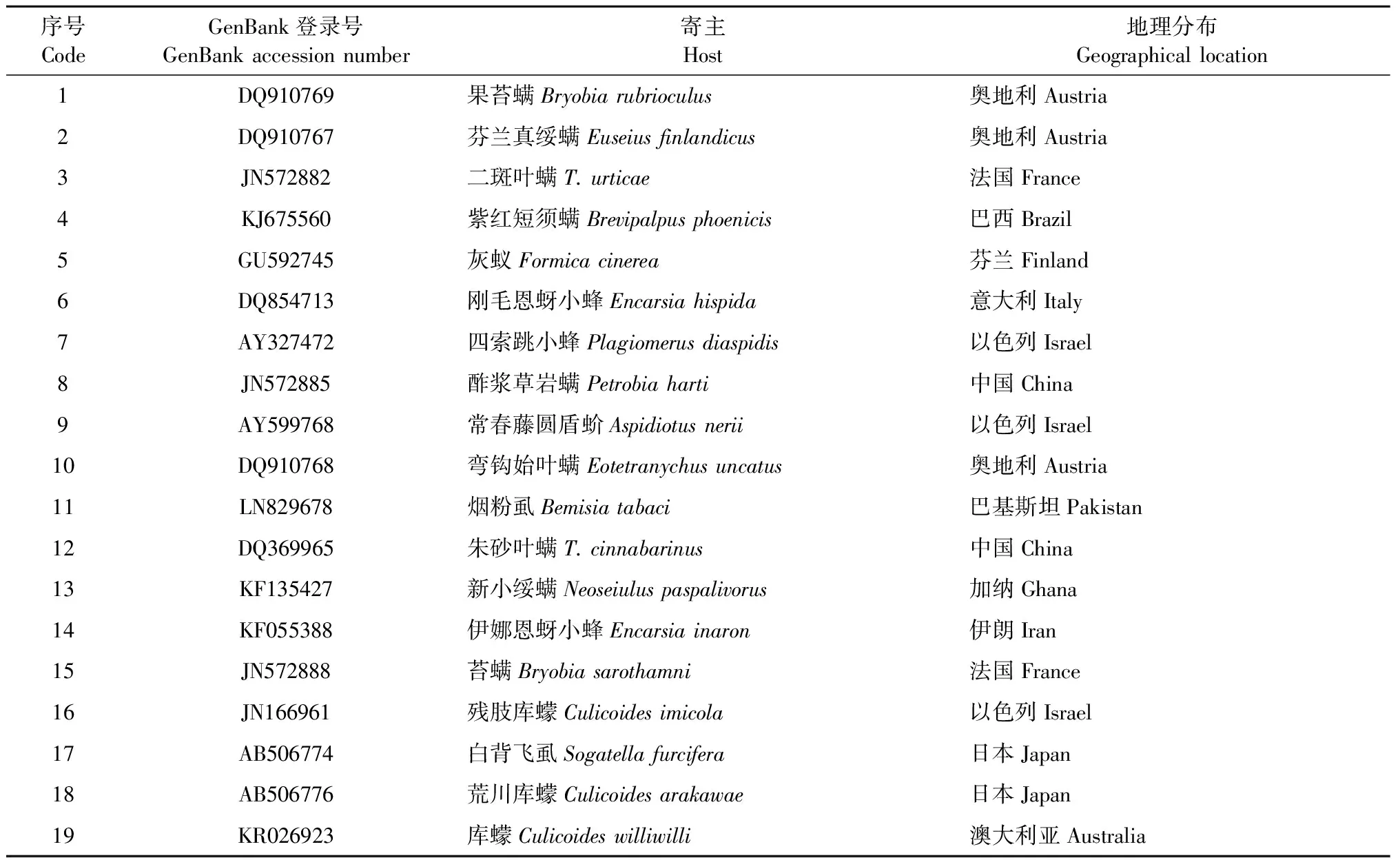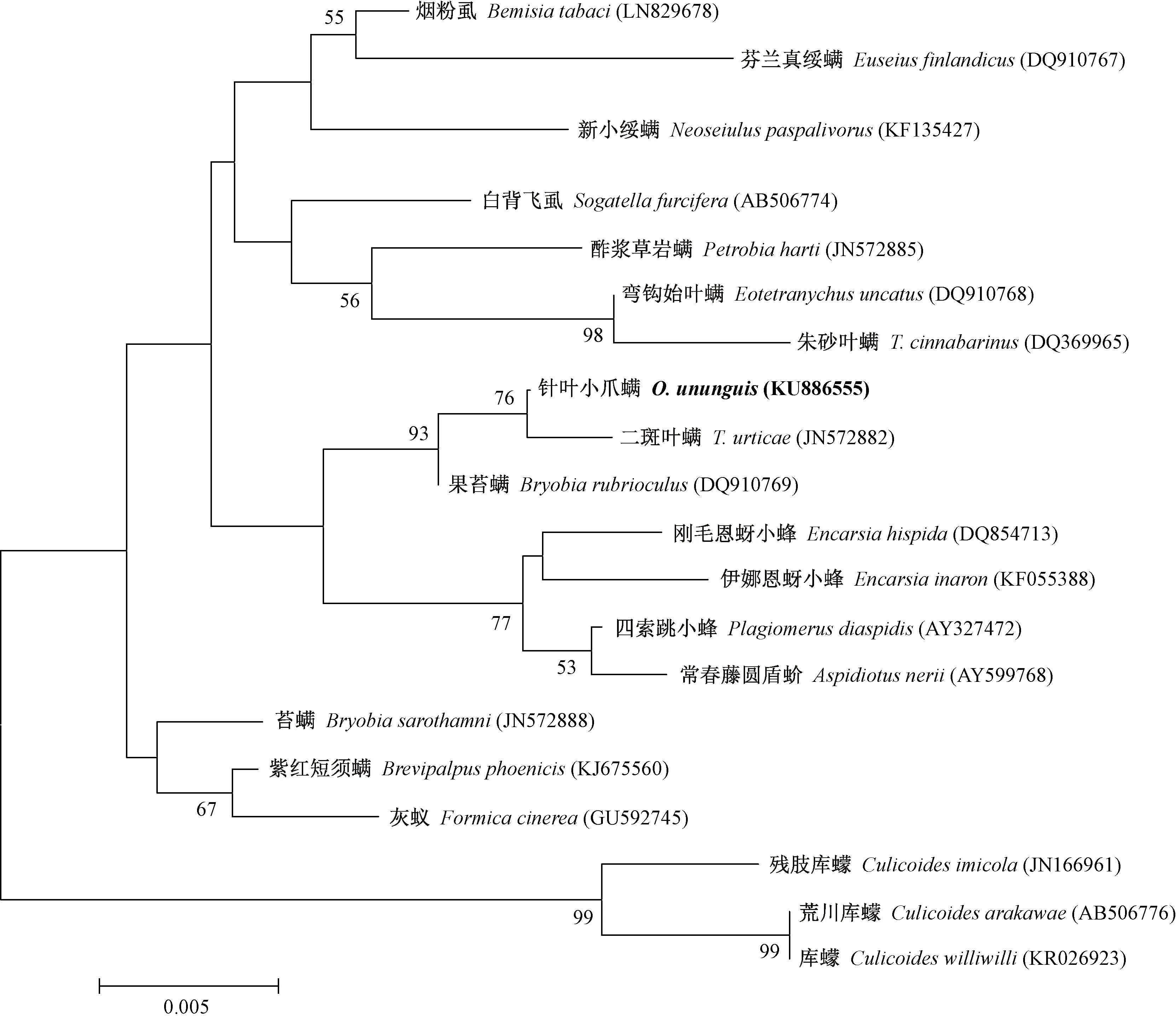针叶小爪螨不同种群内共生菌Wolbachia和Cardinium的检测及系统发育分析*
孙 菲 杨春红 李 波 郑金柱 周成刚 谢丽霞 尹淑艳
(1. 山东农业大学植物保护学院 泰安 271018; 2. 泰安市林业局 泰安 271000; 3.泰安市徂徕山林场 泰安 271000)
针叶小爪螨不同种群内共生菌Wolbachia和Cardinium的检测及系统发育分析*
孙 菲1杨春红1李 波2郑金柱3周成刚1谢丽霞1尹淑艳1
(1. 山东农业大学植物保护学院 泰安 271018; 2. 泰安市林业局 泰安 271000; 3.泰安市徂徕山林场 泰安 271000)
【目的】 针叶小爪螨的山东板栗种群(TSBL)和浙江杉木种群(ZJSM)间存在生殖不亲和,而内共生菌Wolbachia和Cardinium能引起宿主的胞质不亲和等生殖异常现象,明确Wolbachia和Cardinium在针叶小爪螨中的分布情况,为下一步研究其在该螨种群分化中的可能作用及其对该螨的生殖调控作用奠定基础。【方法】 提取单头雌成螨的总DNA,使用特异性引物通过PCR扩增Wolbachia的wsp基因和Cardinium的16S rRNA基因的部分片段,将电泳检测为阳性的PCR产物纯化、测序,以确定所得产物是否为目的基因产物,并进行系统发育分析。【结果】 针叶小爪螨的山东板栗种群(TSBL)和浙江杉木种群(ZJSM)均无Wolbachia和Cardinium感染。所检测的12个针叶小爪螨种群中,Wolbachia和Cardinium的感染率分别是0和8.3%。Cardinium仅在河北麻栎种群中检测到,但种群内感染率较高,为66.7%。感染针叶小爪螨的Cardinium与感染二斑叶螨的Cardinium的亲缘关系较近。【结论】 我国针叶小爪螨中Wolbachia的感染率可能极低,该螨山东板栗种群(TSBL)和浙江杉木种群(ZJSM)间的生殖不亲合与Wolbachia和Cardinium无关。
针叶小爪螨; 种群分化;Wolbachia;Cardinium; 系统发育
Abstract: 【Objective】 There exists reproductive incompatibility between theCastaneamollissimapopulation from Shandong Province (TSBL) and theCunninghamialanceolatapopulation from Zhejiang Province (ZJSM) ofOligonychusununguis. However,WolbachiaorCardinium, as the insect’s endosymbiont, has the ability to alter the reproductive capabilities of its host. This study aims to analyze the distribution ofWolbachiaandCardiniumin differentO.ununguispopulations, and to reveal the effects of endosymbionts onO.ununguisreproductive incompatibility.【Method】 Primers were designed according to the sequences of the gene encoding a surface protein ofWolbachia(wsp) and theCardinium’s 16S rRNA gene, and PCR was performed using the genomic DNA extracted from a single adult femaleO.ununguis. Purified PCR fragments were sequenced and blasted against the databases. Phylogenetic tree was constructed based on these sequences.【Result】 Neither theC.mollissimapopulation from Shandong Province (TSBL) nor theC.lanceolatapopulation from Zhejiang Province (ZJSM) was infected withWolbachia. In all the detected 12 populations ofO.ununguis, the infection rates ofWolbachiaandCardiniumwere 0 and 8.3%, respectively.Cardiniumwas detected only in theQuercusacutissimapopulation from Hebei Province, but the intrapopulation infection rate was high with 66.7%.TheCardiniuminfectingO.ununguiswas closer to that fromTeranychusurticaein phylogenetic relationship.【Conclusion】 The infection rate ofWolbachiamight be very low inO.ununguisin China. The reproductive incompatibility between theC.mollissimapopulation from Shandong Province (TSBL) and theC.lanceolatapopulation from Zhejiang Province (ZJSM) ofO.ununguiswas independent ofWolbachiaandCardinium.
Keywords:Oligonychusununguis; population differentiation;Wolbachia;Cardinium; phylogeny
针叶小爪螨(Oligonychusununguis)是一种分布广、食性广的害螨,广泛分布于亚洲、欧洲、澳洲、美洲的众多国家,寄主植物包括松科(Pinaceae)、柏科(Cupressaceae)、杉科(Taxodiaceae)等针叶树和壳斗科(Fagaceae)、黄杨科(Buxaceae)、胡桃科(Juglandaceae)、桃金娘科(Myrtaceae)、蔷薇科(Rosaceae)等阔叶树(Bollandetal., 1998; Migeonetal., 2011)。我国用材树种杉木(Cunninghamialanceolata)和经济林树种板栗(Castaneamollissima)上的重要害螨一直被认为是针叶小爪螨(王慧芙, 1981; 张时敏, 1982; 孙绪艮等, 1990),但研究发现,该螨的山东板栗种群和浙江杉木种群间存在生殖不亲和,并且这种不亲和基本上可以排除地理隔离的影响,因为浙江板栗种群与山东板栗种群间的杂交是完全亲和的(尹淑艳等, 2010)。
昆虫体内有多种共生菌。在过去20多年中,人们对内共生菌及其引起的宿主生殖异常现象有了较深刻的了解。到目前为止,最受关注且研究最多的参与宿主生殖调控的内共生菌是Wolbachia。Wolbachia属于变形菌门(Proteobacteria)变形菌纲α亚门(Alphaproteobacteria)立克次体目(Rickettsiales)立克次体科(Rickettsiaceae)沃尔巴克氏体属(Wolbachia)(潘晓玲等, 2014)。Wolbachia通过多种方式调控其宿主的生殖活动,包括胞质不亲和(cytoplasmic incompatibility,CI)、孤雌生殖(parthenogenesis induction,PI)、雄性致死(male killing,MK)和雌性化(Feminization)等(Werrenetal., 2008),其中胞质不亲和最普遍也最常见。胞质不亲和有单向不亲和和双向不亲和2种形式。当感染Wolbachia的精子与未感染Wolbachia的卵细胞进行受精时会发生单向不亲和,但未感染的雄性与感染的雌性的杂交是亲和的。单向不亲和是Wolbachia引起寄主胞质不亲和的典型形式,但在尖音库蚊(Culexpipiens)、盾纹伊蚊(Aedesscutellaris)、拟果蝇(Drosophilasimulans)、Nasonia属的某些蜂类和Cryllus属的某些蟋蟀中也有双向不亲和现象的报道,双向不亲和发生在不同的Wolbachia品系之间(Jamesetal., 1999)。Cardinium是继Wolbachia之后第2个被发现能调控宿主生殖行为的共生菌,属于拟杆菌门(Bacteroidetes)鞘脂杆菌纲(Sphingobacteria)鞘脂杆菌目(Sphingobacteriales)屈挠杆菌科(Flexibacteraceae)(董鹏, 2007)。目前已经发现Cardinium能够引起雌性化(Chigiraetal., 2005; Grootetal., 2006)、诱导产雌孤雌生殖(Zchori-Feinetal., 2001)、诱导胞质不亲和(Gotohetal., 2007; Rosetal., 2009; 刘颖等, 2010; Xieetal., 2010; 朱路雨等, 2012; Zhuetal., 2012)等生殖异常现象。
微生物介导的不亲和,尤其是双向不亲和可能在物种分化中起着重要作用(Perrot-Minnotetal., 1996; Bruckeretal., 2012)。针叶小爪螨山东板栗种群与浙江杉木种群间的生殖不亲和是否与其体内的共生菌有关?虽然国外已有多种螨类感染Wolbachia和(或)Cardinium的报道,国内南京农业大学洪晓月教授研究组对二斑叶螨(Tetranychusurticae)、朱砂叶螨(T.cinnabarinus)等多种叶螨的内共生菌感染情况以及内共生菌与宿主的相互作用进行过研究(苗慧等, 2006; Xieetal., 2006, 2010;刘颖等, 2010; 陆明红等, 2011; Yuetal., 2011; 朱路雨等, 2012; Luetal., 2012; Zhuetal., 2012; 丁秀蕾等, 2013; 谢蓉蓉等, 2013; Zhangetal., 2013b; 2013c; 2015; Zhaoetal., 2013a; 2013b; 2013c; 张艳凯等, 2014),但针叶小爪螨内共生菌感染情况未见相关报道,因此对此问题还不得而知。为此,本文利用PCR技术检测了针叶小爪螨山东板栗种群(TSBL)、浙江杉木种群(ZJSM)及其他种群Wolbachia和Cardinium的感染情况,为进一步探讨该螨板栗和杉木种群间的分化机制以及共生菌对该螨的生殖调控作用奠定基础。
1 材料与方法
1.1 样品采集 采集带有螨体的单叶片放入盖上有微孔的小塑料盒中,带回实验室,在解剖镜下挑取雌成螨(每个叶片取1头)于盛有无水乙醇的1.5 mL离心管中,每管1头,置于-20 ℃保存。部分个体保存于75%酒精中,用于形态鉴定。采样时,采样植株间隔距离至少为10 m,同一采样植株上采集的样本间的距离至少为1 m,避免所采集到的样本间有近的亲缘关系。共采集了12个种群(表1)。
1.2 DNA提取及质量检测 DNA提取 方法参照O’Neill等(1992): 将用酒精保存的单头雌成螨浸入蒸馏水中除去酒精,移入TE缓冲液(10 mmol·L-1Tris-HCl,1 mmol·L-1EDTA,pH 8.0)中浸泡1 h,然后将虫体转移至25 μL STE buffer(100 mmol·L-1NaCl,10 mmol·L-1Tris- HCl,1 mmol·L-1EDTA,pH 8.0)中充分研磨,研磨后将离心管置于冰上并向离心管内加 2 μL蛋白酶 K(10 mg·mL-1)。简单离心后, 37 ℃下孵育30 min。95 ℃初始变性5 min。简单离心后,-20 ℃保存或立即取上清(2 μL)作为模板进行PCR。
DNA质量检测 使用线粒体细胞色素C氧化酶亚基Ⅰ基因(COⅠ)片段进行检测,所用引物为5’-TGGGTTTGGAATAGTTTCTCA-3’和5’-CTGTAAATCCTCCAATGGAAA-3’, PCR反应体系和反应条件参照尹淑艳等(2010)。只有得到阳性PCR产物的模板继续用于下一步内共生菌的检测。
1.3Wolbachia检测及感染率计算ftsZ、16S rDNA 和wsp是3个常用的用于检测Wolbachia的基因,其中wsp最灵敏(Hongetal., 2002),本研究使用特异性引物5’-TGGTCCAAATAAGTGATGAAGAAAC-3’与5’-AAAAATTAAACGCTACTCCA -3’,扩增Wolbachia的wsp基因的部分片段(500 bp左右)来检测Wolbachia(Braigetal., 1998)。PCR反应总体系为25 μL,其中含有2 μL DNA 溶液,2×Es Taq MasterMix(康为世纪)12.5 μL,上下游引物(10 μmol·L-1) 各 1 μL,超纯水8.5 μL。反应条件为: 94 ℃预变性2 min; 94 ℃变性30 s,56 ℃退火30 s,72 ℃延伸1 min,35 个循环后72 ℃保温10 min。阳性对照为确定感染Wolbachia的丽蝇蛹集金小蜂(Nasoniavitripennis)的DNA。
扩增产物用含有溴化乙锭的1%琼脂糖凝胶电泳检测。
种群感染率=(感染种群数/检测种群数)×100%,种群内感染率=(某种群感染的个体数/该种群共检测的个体数)×100%。
1.4Cardinium检测及感染率计算 目前用于检测Cardinium的基因主要是16S rRNA基因。本研究使用特异性引物5’-GCGGTGTAAACGCTACTCCA-3’与 5’-ACCTMTTCTTAACTCAAGCCT-3’,扩增Cardinium的16S rRNA基因的部分片段(450 bp左右)来检测Cardinium(Weeksetal., 2003)。PCR反应总体系为25 μL,其中含有2 μL DNA 溶液,2×Es Taq MasterMix(康为世纪)12.5 μL,上下游引物(10 μmol·L-1) 各 1 μL,超纯水8.5 μL。反应条件为: 94 ℃预变性2 min; 94 ℃变性30 s,57 ℃退火30 s,72 ℃延伸1 min,35 个循环后72 ℃保温10 min。阳性对照为确定感染Cardinium的针叶小爪螨的DNA。
扩增产物用含有溴化乙锭的1%琼脂糖凝胶电泳检测。
感染率的计算同Wolbachia。
1.5 测序及序列分析 电泳检测为阳性的PCR产物送上海桑尼生物科技有限公司纯化、双向测序。将所测得的序列在NCBI网站上进行BLAST,以确定所得到的是否为目的序列。
从NCBI网站上下载感染其他节肢动物的Wolbachia的wsp序列和Cardinium的16S rRNA基因序列,用MEGA5.2软件中的ClustalW进行序列比对,并根据 Kimura 2-paramter 模型,采用邻接法(Neighbor-Joining,NJ)构建系统发育树,系统树各分支的置信度(bootstrap)均进行1 000次的重复检验。
2 结果与分析
2.1 针叶小爪螨不同种群中Wolbachia和Cardinium的感染情况 本研究共检测了针叶小爪螨12个种群的Wolbachia和Cardinium的感染情况,每个种群检测的个体数从16到30个不等。由于针叶小爪螨个体很小,而DNA的提取是单头提取,为了排除DNA提取不成功对共生菌检测结果的影响,DNA提取后先对其提取质量进行检测,提取合格的DNA再用于下一步的共生菌检测。由于PCR会受到多种因素的影响,为了保证共生菌检测的准确性,每次检测以确定感染Wolbachia和Cardinium的DNA为阳性对照。检测结果(表1)表明,Wolbachia和Cardinium在针叶小爪螨中的感染率均很低,12个种群共312个个体中均未检测到Wolbachia,而Cardinium仅在河北麻栎种群(HBML)中检测到,种群感染率较低(8.3%,1/12),但种群内感染率较高,达66.7%(12/18)。
2.2 基于16S rRNA基因序列的Cardinium系统发育分析 所检测的河北麻栎种群(HBML)18个个体中,有12个感染了Cardinium,随机选取其中3个样本进行测序,所得序列经BLAST比对确定为目的序列,且3个样本的Cardinium16S rRNA基因序列完全一致。将感染针叶小爪螨的Cardinium16S rRNA基因序列(GenBank 登 录 号: KU886555)在NCBI网站上经 BLAST 比对后,选择相似性较高的相关序列(表2),运用 MEGA5.2软件,根据 Kimura 2-paramter 模型,采用邻接法(NJ)构建系统发育树。结果表明,感染针叶小爪螨的Cardinium与感染二斑叶螨的Cardinium的亲缘关系最近,而与感染朱砂叶螨的Cardinium的亲缘关系较远,二者分别处于2个不同的分支上(图1)。

表1 针叶小爪螨种群采集信息及Wolbachia和Cardinium感染情况Tab.1 Collection information of O. ununguis populations and the infection status of Wolbachia and Cardinium

表2 构建系统发育树时所引用的GenBank中登录的Cardinium 16S rRNA基因序列Tab.2 16S rRNA gene sequences of Cardinium in GenBank quoted for constructing phylogenetic tree

图1 基于 Cardinium 16S rRNA 基因构建的系统发育树(NJ法)Fig.1 Phylogenetic tree based on Cardinium 16S rRNA gene sequences with NJ method
3 讨论
根据生物学物种的概念,生殖上完全隔离的2个群体应该是2个不同的种,但内共生菌Wolbachia、Cardinium等的研究使得生物学物种的概念受到挑战。内共生菌Wolbachia和Cardinium对其宿主的生殖具有调控作用,能引起胞质不亲和等生殖异常现象。为进一步了解引起针叶小爪螨山东板栗种群(TSBL)和浙江杉木种群(ZJSM)间生殖不亲和的因素,本文检测了这2个种群内共生菌的感染情况。结果显示,所检测的2个种群各30个个体均未感染Wolbachia和Cardinium。虽然内共生菌的感染情况会随采样时间、空间等因素而呈现多样性(Sunetal., 2007; Arthoferetal., 2009; Hughesetal., 2011; 谢蓉蓉等, 2013; Zhangetal., 2013c; 张艳凯等, 2014),但由于本文检测个体与杂交试验所用个体为同一采样批次,因此可以排除Wolbachia和Cardinium引起2种群生殖不亲和的可能性。综合本文研究结果及以前有关针叶小爪螨种群分化方面的研究,笔者认为针叶小爪螨的山东板栗种群与浙江杉木种群很可能由于长期适应不同的寄主植物分化成了2个种,但也不能排除鉴定错误,将原本就是不同的2个种误认为是同一个种。由于大多数螨类体型微小,可用于鉴定的特征有限,因此,出现错误鉴定也是正常现象,世界范围分布的二斑叶螨就有40多个异名。为了明确板栗和杉木上叶螨出现分化的原因或明确二者的分类地位,下一步笔者将基于形态特征和分子数据构建针叶小爪螨与小爪螨属中其他物种的系统发育关系。
笔者检测到采自河北秦皇岛麻栎上的针叶小爪螨感染Cardinium,且种群内感染率较高,达66.7%。如前所述,Cardinium能够诱导雌性化、孤雌生殖和胞质不亲和等生殖异常现象,此外,还能影响宿主适合度和改变寄主的产卵行为等(张开军等, 2010)。感染针叶小爪螨河北麻栎种群的Cardinium对寄主有怎样的影响有待进一步研究。
Nakamura等(2009)检测了22种叶螨体内Wolbachia和Cardinium的感染情况,发现Cardinium的感染率为40.9%,Wolbachia的感染率为31.8%,其中小爪螨属叶螨Cardinium的感染率为66.7%(检测6种,4种有感染),Wolbachia的感染率为16.7%(检测6种,1种有感染),而叶螨属叶螨Cardinium的感染率为12.5%(检测8种,1种有感染),Wolbachia的感染率为62.5%(检测8种,5种有感染),这可能说明Cardinium更易感染小爪螨属的叶螨,而Wolbachia更易感染叶螨属的叶螨。综合分析193篇有关螨类细菌多样性的报道,Chaisiri等(2015)发现,相对于其他节肢动物,螨类中更为重要的共生菌可能是Cardinium,而非Wolbachia。因为现在已知有31种螨类感染Wolbachia,但这些感染物种仅分布于所检测14个总科的5个总科中,感染Cardinium的螨类也有31种,但却分布于8个总科中。本文检测了12个针叶小爪螨种群的Wolbachia和Cardinium感染情况,其中1个种群感染Cardinium,所有种群均未检测到有Wolbachia感染,结果与上述文献检测、分析结果较一致。
虽然Wolbachia被认为是节肢动物体内最丰富的胞内共生菌,是研究最为广泛最为深入的内共生菌,但为何有的物种或类群无Wolobachia分布,而有的物种或类群却是Wolbachia寄生的热门宿主,这仍然是一个悬而未决、最具挑战性的问题。采自泰国29个省的89种蚊子中有28.1%(25种)的种类感染Wolbachia,其中按蚊属(Anopheles)的22个种中均未检测到感染。作者认为可能是按蚊在生理上不支持Wolbachia的感染或很少遇到Wolbachia的水平传播事件(Kittayapongetal., 2000)。赤拟谷盗(Triboliumcastaneum)和杂拟谷盗(T.confusum)是亲缘关系很近的2个近缘种,目前尚未有赤拟谷盗体内存在Wolbachia的报道。程超等(2015)将感染Wolbachia的杂拟谷盗与未感染Wolbachia的赤拟谷盗混合饲养,对混合饲养后的赤拟谷盗及赤拟谷盗和杂拟谷盗的正反杂交后代进行检测,均未发现Wolbachia感染,说明Wolbachia在杂拟谷盗和赤拟谷盗种间不存在水平传播。系统发育分析表明Wolbachia存在水平传播(Haineetal., 2005; Hoyetal., 2005; Sintupacheeetal., 2006; Raychoudhuryetal., 2009; Zhangetal., 2013a),且已通过试验证实(Heathetal., 1999; Huigensetal., 2000; 2004; Duronetal., 2010)。为何Wolbachia不能通过水平传播从杂拟谷盗传播到赤拟谷盗,作者推测可能是赤拟谷盗体内含有抑制Wolbachia正常生长繁殖和存活的某种因子(程超等, 2015)。明确Wolbachia不感染的原因,必将有助于进一步深入了解Wolbachia与宿主间的相互作用,为Wolbachia在有害生物防控中的应用奠定更为坚实的基础。
4 结论
Wolbachia和Cardinium在被检测的12个针叶小爪螨种群中的感染率分别为0和8.3%。Cardinium只在河北麻栎种群HBML中检测到,种群内感染率为66.7%。感染河北麻栎种群的Cardinium与感染二斑叶螨的Cardinium亲缘关系最近。
针叶小爪螨泰山板栗种群(TSBL)和浙江杉木种群(ZJSM)间的生殖不亲合与Wolbachia和Cardinium无关。
程 超, 沈加飞, 明庆磊, 2015. 赤拟谷盗和杂拟谷盗体内Wolbachia的感染状况和种间传播. 江苏农业学报, 31(2): 272- 278.
(Cheng C, Shen J F, Ming Q L. 2015. Infection and interspecific transmission ofWolbachiainTriboliumcastaneumandT.confusum. Jiangsu Journal of Agricultural Sciences, 31(2): 272- 278. [in Chinese])
丁秀蕾, 张艳凯, 荣 霞, 等. 2013. 基于wsp基因的叶螨体内Wolbachia株系的多样性与重组分析. 应用昆虫学报, 50(2): 354-361.
(Ding X L, Zhang Y K, Rong X,etal. 2013. Diversity and recombination ofWolbachiastrains in spider mites based on analysis of thewspgene. Chinese Journal of Applied Entomology, 50(2): 354-361. [in Chinese])
董 鹏. 2007. 书虱体内共生菌Wolbachia与Cardinium的分子检测及对书虱生殖调作用的研究. 重庆: 西南大学博士学位论文.
(Dong P. 2007. Molecular detection of endosymbiontsWolbachiaandCardiniumand its reproductive manipulation on psocids. Chongqing:PhD thesis of Southwest University. [in Chinese])
刘 颖, 谢蓉蓉, 洪晓月. 2010. 共生菌Cardinium对朱砂叶螨的生殖调控作用. 昆虫学报, 53(11): 1233-1240.
(Liu Y, Xie R R, Hong X Y. 2010.Manipulation of symbiontCardiniumon the reproduction of the carmine spider mite,Tetranychuscinnabarinus(Boisduval) (Acari:Tetranychidae). Acta Entomologica Sinica, 53(11): 1233-1240. [in Chinese])
陆明红, 谢蓉蓉, 赵臻君, 等. 2011. 二斑叶螨两种群中Wolbachia诱导的胞质不亲和作用的影响因子比较研究. 昆虫学报, 54(9): 1018-1026.
(Lu M H, Xie R R, Zhao Z J,etal. 2011. A comparative study of factors influencing the expression ofWolbachia-inducedcytoplasmic incompatibility in two populations of the two-spotted spider mite,TetranychusurticaeKoch (Acari: Tetranychidae). Acta Entomologica Sinica, 54(9): 1018-1026. [in Chinese])
苗 慧, 洪晓月, 谢 霖, 等. 2006. 二斑叶螨体内感染的Wolbachia的wsp基因序列测定与分析. 昆虫学报, 49(1): 146-153.
(Miao H, Hong X Y, Xie L,etal. 2006. Sequencing and sequence analysis of thewspgene ofWolbachiainTetranychusurticaeKoch (Acari: Tetranychidae). Acta Entomologica Sinica, 49(1): 146-153. [in Chinese])
潘晓玲, 刘起勇, 奚志勇. 2014. 基于昆虫共生菌沃尔巴克氏体的蚊媒和蚊媒病控制研究进展. 中国媒介生物学及控制杂志, 25(1): 1-7.
(Pan X L, Liu Q Y, Xi Z Y. 2014. Advance in developingWolbachiaas a mean to control mosquito and mosquito-borne diseases. Chinese Journal of Vector Biology and Control, 25(1): 1-7. [in Chinese])
孙绪艮, 苗 良. 1990.针叶小爪螨研究初报. 山东农业大学学报, 21(3): 41-46.
(Sun X G, Miao L. 1990. Studies onOligonychusununguis(Jacobi). Journal of Shandong Agricultural University, 21(3): 41-46. [in Chinese])
王慧芙. 1981. 中国经济昆虫志.第二十三册.螨目.叶螨总科. 北京:科学出版社.
(Wang H F. 1981. Economic Insect Fauna of China. Fasc. 23. Acariformes. Tetranychoidea. Beijing:Science Press. [in Chinese])
谢蓉蓉, 陈小琳, 孙荆涛, 等. 2013. 共生菌Wolbachia在中国二斑叶螨种群中的扩散规律. 应用昆虫学报, 50(2): 345 -353.
(Xie R R, Chen X L, Sun J T,etal. 2013. A comparative study of the dynamics ofWolbachiainfection in different populations ofTetranychusurticae(Acari: Tetranychidae). Chinese Journal of Applied Entomology, 50(2): 345 -353. [in Chinese])
尹淑艳, 于新社, 郭慧玲, 等. 2010. 针叶小爪螨板栗和杉木种群间的遗传分化和杂交试验. 昆虫学报, 53(5): 555-563.
(Yin S Y, Yu X S, Guo H L,etal. 2010. Genetic differentiation and cross-breeding experiments betweenOligonychusununguis(Acari: Tetranychidae) populations from host plantsCastaneamollissimaandCunninghamialanceolata. Acta Entomologica Sinica,53(5): 555-563. [in Chinese])
张开军, 谢蓉蓉, 洪晓月. 2010. 胞内共生菌Cardinium的研究进展. 南京农业大学学报, 33(5): 1-11.
(Zhang K J, Xie R R, Hong X Y. 2010. Research progress of endosymbiontCardinium. Journal of Nanjing Agricultural University, 33(5): 1-11. [in Chinese])
张时敏. 1982. 针叶小爪螨初步观察. 林业科技通讯, (3): 30-32.
(Zhang S M. 1982.Preliminary observation onOligonychusununguis. Forest Science and Technology, (3): 30-32. [in Chinese])
张艳凯, 孙 兵, 洪晓月. 2014.Wolbachia在山楂双叶螨中的感染及对寄主生殖的影响. 昆虫学报, 57(8): 914-920.
(Zhang Y K, Sun B, Hong X Y. 2014.Infection and reproductive effects ofWolbachiain the hawthorn spider mite,Amphitetranychusviennensis(Acarina: Tetranychidae). Acta Entomologica Sinica, 57(8): 914-920. [in Chinese])
朱路雨, 蒋欣雨, 杨思霞, 等. 2012.Wolbachia和Cardinium对皮氏叶螨生殖的影响及在寄主体内的定位. 昆虫学报, 55(6): 684-693.
(Zhu L Y, Jiang X Y, Yang S X,etal. 2012. Reproductive effects and localization ofWolbachiaandCardiniumin the spider miteTetranychuspiercei(Acari: Tetranychidae). Acta Entomologica Sinica, 55(6): 684-693. [in Chinese])
Arthofer W, Riegler M, Schneider D,etal. 2009. HiddenWolbachiadiversity in field populations of the European cherry fruit fly, Rhagoletis cerasi (Diptera, Tephritidae). Mol Ecol, 18(18): 3816-3830.
Bolland, H R, Gutierrez J, Flechtmann C H W. 1998. World catalogue of the spider mites family Acari: Tetranychidae with references to taxonomy, synonymy, host pests and distribution. Academic Publ Brill.
Brucker R M, Bordenstein S R. 2012. Speciation by symbiosis. Trends in Ecology and Evolution, 27(8): 443-451.
Chaisiri K, McGarry J W, Morand S,etal. 2015. Symbiosis in an overlooked microcosm: a systematic review of the bacterial flora of mites. Parasitology, 142(9): 1152-1162.
Chigira A, Miura K. 2005. Detection of the ‘CandidatusCardinium’ bacteria from the haploid hostBrevipalpuscalifornicus(Acari: Tenuipalpidae) and effect on the host. Exp Appl Acarol, 37(1/2): 107-116.
Duron O, Wilkes T E, Hurst G D. 2010. Interspecifc transmission of a male-killing bacterium on an ecological timescale. Ecol Lett, 13(9): 1139-1148.
Gotoh T, Noda H, Ito S. 2007.Cardiniumsymbionts cause cytoplasmic incompatibility in spider mites. Heredity, 98(1): 13-20.
Groot T V M, Breeuwer J A J. 2006.Cardiniumsymbionts induce haploid thelytoky in most clones of three closely relatedBrevipalpusspecies. Exp Appl Acarol, 39(3/4): 257-271.
Haine E R, Pickup N J, Cook J M. 2005. Horizontal transmission ofWolbachiain aDrosophilacommunity. Ecol Entomol, 30(4): 464-472.
Heath B D, Butcher R D J, Whitfeld W G F,etal.1999. Horizontal transfer ofWolbachiabetween phylogenetically distant insect species by a naturally occurring mechanism. Curr Biol, 9(6): 313-316.
Hong X Y,Gotoh T, Noda H. 2002. Sensitivity comparison of PCR primers for detectingWolbachiain spider mites. Appl Entomol Zool, 37(3): 379-383.
Hoy M A, Jeyaprakash A. 2005. Microbial diversity in the predatory miteMetaseiulusoccidentalis(Acari: Phytoseiidae) and its prey,Tetranychusurticae(Acari: Tetranychidae). Biological Control, 32(3): 427-441.
Hughes G L, Allsopp P G, Brumbley S M,etal. 2011. Variable infection frequency and high diversity of multiple strains ofWolbachiapipientis inPerkinsiellaplanthoppers. Appl Environ Microbiol, 77(6): 2165-2168.
Huigens M E, Luck R F, Klaassen R H,etal. 2000. Infectious parthenogenesis. Nature, 405(6783): 178-179.
Huigens M E, de Almeida R P, Boons P A H,etal. 2004. Natural interspecifc and intraspecifc horizontal transfer of parthenogenesis-inducingWolbachiainTrichogrammawasps. Proc Natl Acad Sci USA, 271(1538): 509-515.
James M C, Robert D J B. 1999. The transmission and effect ofWolbachiabacteria in parasitoids. Res Popul Ecol, 41(1): 15-28.
Kittayapong P, Baisley K J, Baimai V,etal. 2000. Distribution and diversity ofWolbachiainfections in Southeast Asian mosquitoes. J Med Entomol, 37(3): 340-345.
Lu M H, Zhang K J, Hong X Y. 2012. Tripartite associations among bacteriophage WO,Wolbachia, and host affected by temperature and age inTetranychusurticae. Exp Appl Acarol, 58(3): 207-220.
Migeon A, Dorkeld F. 2006-2017. Spider Mites Web: a comprehensive database for the Tetranychidae. [2015-01-10]http:∥www.montpellier.inra.fr/CBGP/spmweb.
Nakamura Y, Kawai S, Yukuhiro F,etal. 2009. Prevalence ofCardiniumbacteria in planthoppers and spider mites and taxonomi revision ofCandidatusCardinium hertigii based on detection of a newCardiniumgroup from biting midges. Appl Environ Microbiol, 75(21): 6757-6763.
O’Neill S L, Giordano R, Colbert A M,etal. 1992. 16S rRNA phylogenetic analysis of the bacterial endosymbionts associated with cytoplasmic incompatibility in insects. Proc Natl Acad Sci, USA, 89(7): 2699-2702.
Perrot-Minnot M J, Guo L, Werren J H. 1996. Single and double infections ofWolbachiain the parasitic waspNasoniavitripennis: effects on compatibility. Genetics, 143(2): 961-972.
Raychoudhury R, Baldo L, Oliveira D C S G,etal. 2009. Modes of acquisition ofWolbachia: horizontal transfer, hybrid introgression, and codivergence in theNasoniaspecies complex. Evolution, 63(1):165-183.
Ros V I D, Breeuwer J A J. 2009. The effects of, and interactions between,CardiniumandWolbachiain the doubly infected spider miteBryobiasarothamni(Acari: Tetranychidae). Heredity, 102(4): 413-422.
Sintupachee S, Milne J R, Poonchaisri S,etal. 2006. Closely relatedWolbachiastrains within the pumpkin arthropod community and the potential for horizontal transmission via the plant. Microb Ecol, 51(3): 294-301.
Sun X, Cui L, Li Z. 2007. Diversity and phylogeny ofWolbachiainfectingBactroceradorsalis(Diptera: Tephritidae) populations from China. Environ Entomol, 36(5): 1283-1289.
Werren J H, Baldo L, Clark M E. 2008.Wolbachia: master manipulators of invertebrate biology. Nat Rev Microbiol, 6(10): 741-751.
Xie R R, Liu Y, Hong X Y,etal. 2006. Effect of infection rate ofWolbachiaon the reproduction inTetranychuskanzawaiKishida (Acari: Tetranychidae) in China. Int J Acarol, 32(4): 407-415.
Xie R R, Zhou L L, Zhao Z J,etal. 2010. Male age influences the strength ofCardinium-inducedcytoplasmic incompatibility expression in the carmine spider miteTetranychuscinnabarinus. Appl Entomol Zool, 45(3): 417-423.
Yu M Z, Zhang K J, Xue X F,etal. 2011. Effects ofWolbachiaon mtDNA variation and evolution in natural populations ofTetranychusurticaeKoch. Insect Mol Biol, 20(3): 311-321.
Zchori-Fein E, Gottlieb Y, Kelly S E,etal. 2001. A newly discovered bacterium associated with parthenogenesis and a change in host selection behavior in parasitoid wasps. Proc Natl Acad Sci USA, 98(22): 12555-12560.
Zhang Y K, Ding X L, Rong X,etal. 2015. How do hosts react to endosymbionts? A new insight into the molecular mechanisms underlying theWolbachia-hostassociation. Insect Mol Biol, 24(1): 1-12.
Zhang K J, Han X, Hong X Y. 2013a. Various infection status and molecular evidence for horizontal transmission and recombination ofWolbachiaandCardiniumamong rice planthoppers and related species. Insect Sci, 20(3): 329-344.
Zhang Y K, Ding X L, Zhang K J,etal. 2013b.Wolbachiaplay an important role in affecting mtDNA variation ofTetranychustruncatus(Trombidiformes: Tetranychidae). Environ Entomol, 42(6): 1240-1245.
Zhang Y K, Zhang K J, Sun J T,etal. 2013c. Diversity ofWolbachiain natural populations of spider mites (genusTetranychus): evidence for complex infection history and disequilibrium distribution. Microb Ecol, 65(3): 731-739.
Zhao D X, Chen D S, Ge C,etal. 2013a. Multiple infections withCardiniumand two strains ofWolbachiain the spider miteTetranychusphaselusEhara: revealing new forces driving the spread ofWolbachia. PLoS One, 8(1): e54964.
Zhao D X, Zhang X F, Chen D S,etal. 2013b.Wolbachia-hostinteractions: host mating patterns affectWolbachiadensity dynamics. PLoS One, 8(6): e66373.
Zhao D X, Zhang X F, Hong X Y. 2013c. Host-symbiont interactions in spider miteTetranychustruncatesdoubly infected withWolbachiaandCardinium. Environ Entomol, 42(3): 445-452.
Zhu L Y, Zhang K J, Zhang Y K,etal. 2012.Wolbachiastrengthenscardinium-inducedcytoplasmic incompatibility in the spider miteTetranychuspierceiMcGregor. Curr Microbiol, 65(5): 516-523.
Zug R, Hammerstein P. 2012. Still a host of hosts forWolbachia: analysis of recent data suggests that 40% of terrestrial arthropod species are infected. PLoS One, 7(6): e38544.
(责任编辑 朱乾坤)
DetectionofWolbachiaandCardiniumEndosymbiontsinDifferentOligonychusununguisPopulationsandPhylogeneticAnalysisofCardinium
Sun Fei1Yang Chunhong1Li Bo2Zheng Jinzhu3Zhou Chenggang1Xie Lixia1Yin Shuyan1
(1.CollegeofPlantProtection,ShandongAgriculturalUniversityTai’an271018; 2.ForestryBureauofTaianCityTai’an271000; 3.ForestFarmofMountCulaiTai’an271000)
S718.83
A
1001-7488(2017)08-0141-08
10.11707/j.1001-7488.20170816
2016-06-28;
2016-11-07。
山东省高等学校科技计划项目(J14LE14); 国家自然科学基金项目(31401957)。
* 尹淑艳为通讯作者。

